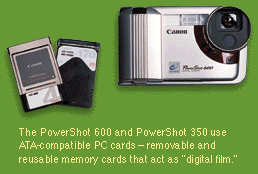
|
The Digital Difference



 igital cameras "paint with light" in a similar way, using a lens, aperture and shutter. But digital cameras use their electronic image sensors (known as CCDs, or charge-coupled devices) and signal processing technology to convert the light into electronic or digital information. This information (the image) is then compressed so many images can be saved onto the camera's storage device, such as a removable hard drive or memory card. Once saved, it can then be transferred to a computer for manipulation, printing, transmission to another computer via modem or archival storage. An easy way to differentiate traditional versus digital photography is the way Canon positions its PowerShot products - "PCs that take pictures." igital cameras "paint with light" in a similar way, using a lens, aperture and shutter. But digital cameras use their electronic image sensors (known as CCDs, or charge-coupled devices) and signal processing technology to convert the light into electronic or digital information. This information (the image) is then compressed so many images can be saved onto the camera's storage device, such as a removable hard drive or memory card. Once saved, it can then be transferred to a computer for manipulation, printing, transmission to another computer via modem or archival storage. An easy way to differentiate traditional versus digital photography is the way Canon positions its PowerShot products - "PCs that take pictures."

 In place of conventional film, the PowerShot 600 uses 1MB of internal memory to store up to 18 images and can store up to 72 images with an optional 4MB compact flash memory PCMCIA card. An optional 170MB hard disk drive PCMCIA card makes it possible to store up to 3,000 photos at 832 x 608 resolution.
In place of conventional film, the PowerShot 600 uses 1MB of internal memory to store up to 18 images and can store up to 72 images with an optional 4MB compact flash memory PCMCIA card. An optional 170MB hard disk drive PCMCIA card makes it possible to store up to 3,000 photos at 832 x 608 resolution.

 By supporting ATA-compatible PC Cards in the PowerShot 600 and PowerShot 350, Canon has created the equivalent of "digital film" that permits users to remove cards loaded with images and insert a fresh card to continue shooting without having to stop to transfer images from the camera to the PC. Unlike conventional film, the PCMCIA cards are reusable once the images have been downloaded and erased.
By supporting ATA-compatible PC Cards in the PowerShot 600 and PowerShot 350, Canon has created the equivalent of "digital film" that permits users to remove cards loaded with images and insert a fresh card to continue shooting without having to stop to transfer images from the camera to the PC. Unlike conventional film, the PCMCIA cards are reusable once the images have been downloaded and erased.

 Once the image is in the computer, the user can manipulate it with image manipulation software, such as Ulead's PhotoImpact™, which Canon ships with its PowerShot 600 and PowerShot 350 digital cameras, Canon Stitch and Canon TimeTunnel, which allow users to create panoramic prints out of multiple images or catalog images respectively, or a product like Adobe Photoshop.
Once the image is in the computer, the user can manipulate it with image manipulation software, such as Ulead's PhotoImpact™, which Canon ships with its PowerShot 600 and PowerShot 350 digital cameras, Canon Stitch and Canon TimeTunnel, which allow users to create panoramic prints out of multiple images or catalog images respectively, or a product like Adobe Photoshop.


|


 igital cameras "paint with light" in a similar way, using a lens, aperture and shutter. But digital cameras use their electronic image sensors (known as CCDs, or charge-coupled devices) and signal processing technology to convert the light into electronic or digital information. This information (the image) is then compressed so many images can be saved onto the camera's storage device, such as a removable hard drive or memory card. Once saved, it can then be transferred to a computer for manipulation, printing, transmission to another computer via modem or archival storage. An easy way to differentiate traditional versus digital photography is the way Canon positions its PowerShot products - "PCs that take pictures."
igital cameras "paint with light" in a similar way, using a lens, aperture and shutter. But digital cameras use their electronic image sensors (known as CCDs, or charge-coupled devices) and signal processing technology to convert the light into electronic or digital information. This information (the image) is then compressed so many images can be saved onto the camera's storage device, such as a removable hard drive or memory card. Once saved, it can then be transferred to a computer for manipulation, printing, transmission to another computer via modem or archival storage. An easy way to differentiate traditional versus digital photography is the way Canon positions its PowerShot products - "PCs that take pictures."